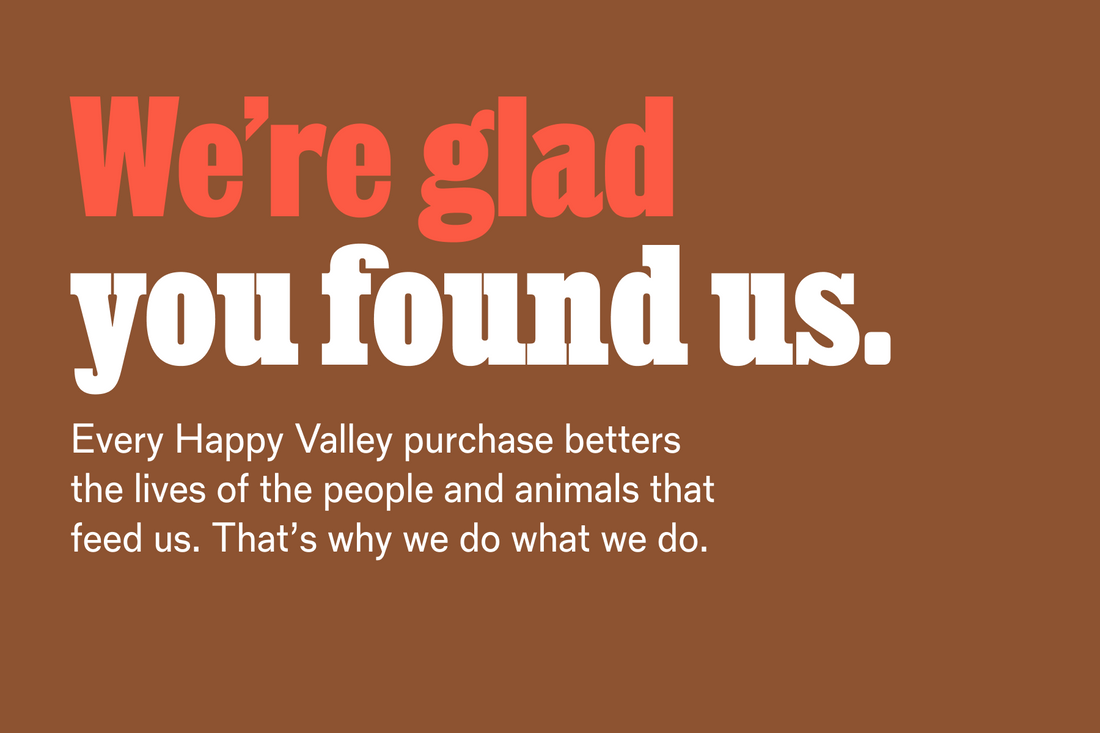A radically different way to raise beef.
Before joining the Happy Valley team, I raised grass-fed livestock and spent a lot of time moving portable electric fences. I never looked forward to setting up fencing - a rare moment when high school interns proved useful. I especially dreaded putting fencing up in the forest for the goats. There was an abundance of ticks and poison ivy to avoid (I never could) and the terrain could twist many ankles (it did). But, the goats absolutely loved it. One of their favorite treats is poison ivy and the trees provided shade and protection from the wind and rain.
On the flip side, setting up fences in open, grassy pastures was fast and easy. There were few obstacles and, at worst, I’d get a sunburn. However, on sunny days, the cows or sheep would huddle in whatever shade they could find and drink ENORMOUS amounts of water. On the hottest days, we would fill a 300-gallon water trough four times for just about 20 cows. 6,000 gallons of water. That’s about as much water as a tanker truck can hold. The cattle would drink about half of that when we had them in a shade abundant pasture.
Other than the annoyance of setting up fences in the forest, why don’t more ranchers graze their cattle in tree havens? The current model of American and European grazing is to have neat grassy and open pastures with brushy or woody hedgerows separating paddocks or delineating property boundaries.

This wasn’t always the way. Increased mechanization made forest-clearing easier, while post-war designs for monocultures and fragmented land ownership led to the decline of silvopasture. Silvopasture is the combination of trees and pasture and it could have a resurgence as environmentalists and ranchers alike look for more sustainable ways to raise beef and keep up with growing worldwide demand. In fact, silvopasture is one of the top ten most effective ways to sequester carbon.
Conventional beef gets a bad environmental rep, and deservingly so. At the moment, best estimates show that it takes 1,440,000 gallons of water and nine acres of land to raise one cow to slaughter, while emitting 22,400 pounds of CO2. But, let’s not get ahead of ourselves and blame innocent cows themselves. Human management, not cows inherently, drive these numbers to baffling heights. Focus on quarterly profit, instead of long-term sustainability and regeneration, has created an industry that extracts, pollutes and wastes.
So what is regenerative agriculture?

Ruminants (think cows chewing their cud - ruminating) play a crucial role in our ecosystems. Pre-colonization of North America, huge herds of bison would roam the prairie, and they would never stop moving. They spread their manure far and wide, fertilizing all the land they visited. By continuously moving and not returning to the same land for a year or two, they allowed the grassroots to regrow and strengthen, accessing nutrients deep within the soil. These same strong root systems are crucial to holding topsoil in place, preventing erosion and improving water holding capacity (i.e. no flooding). Further, grazing animals will trample carbon-rich organic matter into the soil, preventing wildfire and adding more nutrients to the soil.
The same thing can be done with cattle. To overly simplify things, it’s as easy as moving them to fresh pastures regularly and allowing pasture to rest before returning to them. Now, place them among natural carbon recyclers (trees) and you truly have an environmentally regenerative system.
Regenerative grazing practices, such as silvopasture, can reverse industry tendencies of mismanagement and potentially improve a farmer’s bottom line. Cattle raised among trees are less prone to heat stress and can more effectively stay cool. Less stress and less energy dedicated to keeping warm translate to a faster rate of weight gain. Farmers can also plant protein-rich edible trees, adding to the productivity of their pasture. Also, farmers can seamlessly integrate a logging operation within their beef production. Free money!
Is Silvopasture the holy grail of agriculture?

Switching to silvopasture sounds like a no brainer, right? Among others, I see three big boundaries to it taking hold. First, trees take years to grow. Planning and implementing a silvopasture is an exercise in pushing human patience and foresight to the limit. Second, shifting the way farmers think about farming beef. This is a radically different way of raising beef, requiring an entirely new mindset of what it means to be a beef farmer and essentially become a tree farmer, too. Third, shifting the way consumers think about beef. The only way farmers will switch to silvopasture beef is if there’s a market for it.
Silvopasture is a complex system, of which I’ve only grazed the surface. For consumers to demand beef raised among trees, they’ll need to understand why silvopasture is an important tool. That being said, let’s get started. Here’s some history, a brief Cornell guide to establishing silvopasture, a bit of government support, a silvopasture case study, a bit about edible silvopasture, some reasons for silvopasture by a silvopasture expert, and a photo guide.
Instagram Live
Have questions about the way we do things and what our impact is? Tune in to Instagram Live on 5.6.20 at 6pm EST. Dan Honig, Owner of HVMC and Jon Nodler of Cadence Restaurant will be answering your questions.

